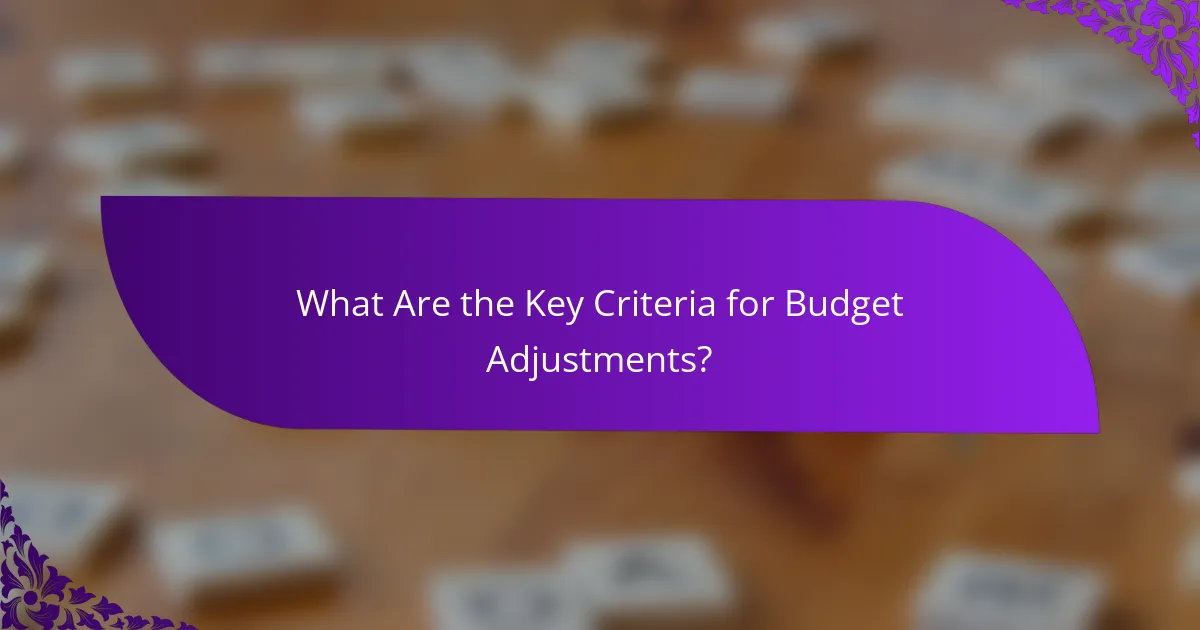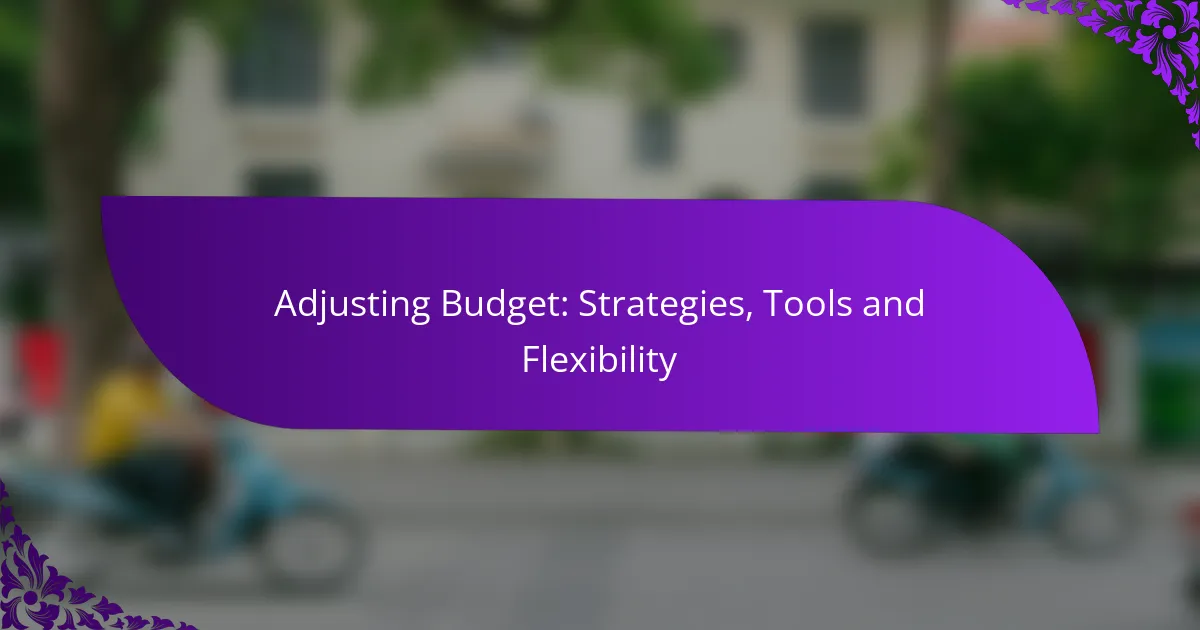Adjusting a budget is essential for organizations to remain responsive to changing circumstances and to ensure that financial resources are used effectively. By employing various strategies and utilizing specialized tools, organizations can maintain flexibility and align their budgets with current priorities. Regular assessments and contingency planning further enhance the ability to adapt to unexpected expenses, fostering a proactive financial management approach.

What Are Effective Budget Adjustment Strategies?
Effective budget adjustment strategies are methods that help organizations modify their budgets in response to changing circumstances. These strategies ensure that financial resources are allocated efficiently and align with current priorities and goals.
Zero-based budgeting
Zero-based budgeting (ZBB) requires that every expense must be justified for each new period, starting from a “zero base.” This approach encourages managers to think critically about their spending and prioritize essential activities. It can lead to significant cost savings but may require more time and effort to implement.
To apply ZBB, begin by identifying all expenses and categorizing them into necessary and discretionary. Focus on justifying each expense based on current needs rather than historical spending patterns.
Incremental budgeting
Incremental budgeting adjusts the previous year’s budget by a fixed percentage or amount, making it a straightforward method for budget adjustments. This approach is easy to implement but can perpetuate inefficiencies if past expenditures are not critically assessed.
When using incremental budgeting, consider factors such as inflation or changes in operational needs. While it simplifies the budgeting process, be cautious of simply rolling over past budgets without evaluating their relevance.
Flexible budgeting
Flexible budgeting allows for adjustments based on actual activity levels, making it adaptable to changes in business conditions. This method is particularly useful for organizations with fluctuating revenues or costs, as it provides a more accurate financial picture.
To create a flexible budget, establish variable and fixed costs, then adjust the budget based on actual output or sales levels. This approach helps in identifying performance variances and can guide decision-making effectively.
Rolling forecasts
Rolling forecasts involve continuously updating budget projections based on the latest data and trends, typically extending over a set period, such as 12 months. This strategy allows organizations to remain agile and responsive to market changes.
Implementing rolling forecasts requires regular data analysis and collaboration across departments. Set a schedule for updates, such as quarterly or monthly, to ensure that forecasts reflect the most current information and strategic goals.
Activity-based budgeting
Activity-based budgeting (ABB) focuses on the costs of activities necessary to produce goods or services. This method helps organizations understand the true cost drivers and allocate resources more effectively based on activities that add value.
To implement ABB, identify key activities and assign costs to them based on resource consumption. This approach can lead to more informed decision-making and improved cost control, but it may require detailed data collection and analysis.

Which Tools Can Help Adjust Budgets?
Several tools can effectively assist in adjusting budgets, each offering unique features tailored to different financial needs. These tools range from comprehensive accounting software to simple budgeting apps, helping users track expenses, forecast future spending, and maintain financial flexibility.
QuickBooks
QuickBooks is a robust accounting software widely used by small to medium-sized businesses for budget management. It allows users to create budgets based on historical data, track expenses in real-time, and generate detailed financial reports.
Consider using QuickBooks if you require advanced features like invoicing, payroll, and tax preparation. However, be aware that it may come with a steeper learning curve and higher costs compared to simpler tools.
Mint
Mint is a free budgeting tool that connects to your bank accounts to track spending and create budgets automatically. It categorizes transactions, provides insights into spending habits, and sends alerts for bill payments and budget limits.
This tool is ideal for individuals looking for an easy-to-use interface without the need for extensive accounting knowledge. However, it may not offer the depth of features that businesses require for comprehensive financial management.
YNAB (You Need A Budget)
YNAB is a proactive budgeting tool designed to help users allocate every dollar they earn to specific expenses or savings goals. It emphasizes the importance of planning ahead and adjusting budgets based on real-time financial situations.
With YNAB, users can set up goals, track their progress, and adjust their budgets as needed. While it requires a subscription fee, many find its structured approach to budgeting beneficial for long-term financial health.
Microsoft Excel
Microsoft Excel is a versatile spreadsheet program that can be customized for budgeting purposes. Users can create detailed budgets using formulas, charts, and pivot tables to analyze their financial data effectively.
Excel is ideal for those who prefer a hands-on approach and have experience with spreadsheet software. However, it requires more manual input and management compared to automated budgeting tools.
FreshBooks
FreshBooks is primarily an invoicing and accounting software that also offers budgeting features for small businesses. It allows users to track expenses, manage client billing, and generate financial reports to assess budget performance.
This tool is beneficial for freelancers and small business owners who need to manage both budgets and client invoicing in one place. Keep in mind that its primary focus is on invoicing, so it may not be as comprehensive for personal budgeting needs.

How to Ensure Flexibility in Budgeting?
Ensuring flexibility in budgeting involves creating a budget that can adapt to changing circumstances and unexpected expenses. This can be achieved through regular assessments, contingency plans, scenario analyses, and effective communication with stakeholders.
Regular reviews
Conducting regular reviews of your budget allows you to assess its performance and make necessary adjustments. Aim to review your budget monthly or quarterly, depending on your financial situation and business cycle.
During these reviews, compare actual spending against your budgeted amounts to identify variances. This practice helps in recognizing trends and making informed decisions about reallocating funds or cutting costs.
Contingency planning
Contingency planning involves setting aside a portion of your budget for unexpected expenses or emergencies. A common guideline is to allocate around 5-10% of your total budget for contingencies, depending on your industry and risk factors.
Having a contingency fund provides a financial cushion that can be tapped into when unforeseen costs arise, such as equipment failures or sudden market changes, ensuring your operations remain uninterrupted.
Scenario analysis
Scenario analysis helps you prepare for various financial situations by modeling different outcomes based on changes in key variables. This could include best-case, worst-case, and most likely scenarios regarding revenue, expenses, and market conditions.
By evaluating these scenarios, you can develop strategies to mitigate risks and capitalize on opportunities, allowing your budget to remain flexible in the face of uncertainty.
Stakeholder communication
Effective communication with stakeholders is crucial for maintaining flexibility in budgeting. Regularly update team members, investors, and other relevant parties about budget performance and any necessary adjustments.
Encouraging feedback and collaboration can lead to better decision-making and a shared understanding of financial priorities, ultimately enhancing the adaptability of your budget to meet changing needs.

What Are the Key Criteria for Budget Adjustments?
Key criteria for budget adjustments include alignment with business goals, current market conditions, resource availability, and performance metrics. Evaluating these factors helps organizations make informed decisions about reallocating funds effectively.
Business goals alignment
Ensuring that budget adjustments align with business goals is crucial for maintaining strategic focus. Organizations should regularly review their objectives and determine if current spending supports these aims. For instance, if a company shifts its focus to digital marketing, reallocating funds from traditional advertising may be necessary.
To achieve alignment, consider creating a checklist of business goals and mapping out how each budget item contributes to them. This approach helps identify areas where cuts or increases can be made without compromising overall strategy.
Market conditions
Market conditions significantly impact budget adjustments, as economic shifts can affect revenue and expenses. For example, during a recession, companies may need to tighten budgets to maintain cash flow, while a booming market might allow for increased investment in growth initiatives.
Monitoring key indicators such as consumer spending, inflation rates, and industry trends can provide insights into necessary budget changes. Regularly updating forecasts based on these conditions can help organizations stay agile and responsive.
Resource availability
Resource availability is another critical factor in budget adjustments. This includes not only financial resources but also human capital and technology. If a company faces a shortage of skilled labor or essential tools, it may need to adjust its budget to prioritize recruitment or technology upgrades.
To assess resource availability, conduct a thorough inventory of current assets and capabilities. This evaluation can reveal gaps that require budgetary attention, ensuring that resources are allocated where they are most needed.
Performance metrics
Performance metrics provide valuable insights into how effectively a budget is being utilized. By analyzing key performance indicators (KPIs), organizations can identify underperforming areas and make necessary adjustments. For example, if a marketing campaign is yielding low returns, reallocating funds to more successful initiatives may be warranted.
Establish a regular review process for performance metrics, focusing on both financial and operational data. This practice helps ensure that budget adjustments are data-driven and aligned with overall performance goals.

How to Choose the Right Budgeting Method?
Choosing the right budgeting method involves assessing your financial goals, organizational structure, and available resources. Different methods, such as zero-based budgeting or incremental budgeting, cater to varying needs and can significantly impact financial management.
Evaluate organizational needs
Evaluating organizational needs is crucial in selecting an appropriate budgeting method. Start by identifying the specific financial objectives, such as cost reduction, revenue growth, or resource allocation, that your organization aims to achieve. Understanding these needs will guide you in choosing a method that aligns with your strategic goals.
Consider the size and complexity of your organization as well. Larger organizations may benefit from more structured approaches like program budgeting, while smaller entities might find simpler methods, such as line-item budgeting, more effective. Assessing the current financial situation and forecasting future needs can also inform your decision.
Engage stakeholders in the evaluation process to gather insights on their expectations and requirements. This collaborative approach ensures that the chosen budgeting method is practical and meets the diverse needs of the organization, ultimately leading to better financial outcomes.
